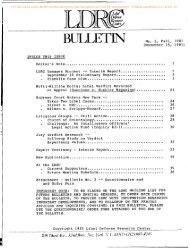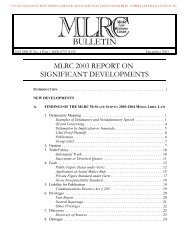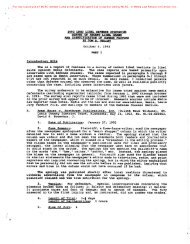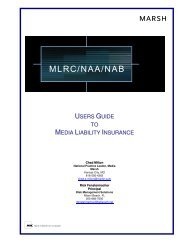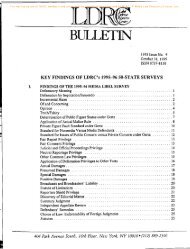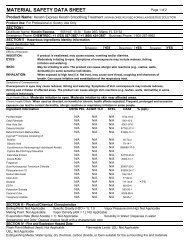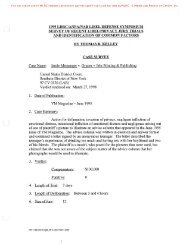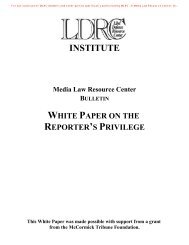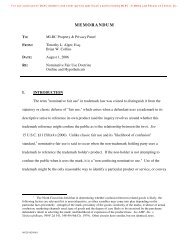2006 MLRC/NAA/NAB LIBEL DEFENSE ... - Directrouter.com
2006 MLRC/NAA/NAB LIBEL DEFENSE ... - Directrouter.com
2006 MLRC/NAA/NAB LIBEL DEFENSE ... - Directrouter.com
You also want an ePaper? Increase the reach of your titles
YUMPU automatically turns print PDFs into web optimized ePapers that Google loves.
For exclusive use of <strong>MLRC</strong> members and other parties specifically authorized by <strong>MLRC</strong>. © Media Law Resource Center, Inc.Material Falsity Interrogatory: It was not entirely clear from the interviews, but itseemed that any mistake in a story that misreports the facts was going to be viewed asmaterially false. There did not seem to be any middle ground for a mistake without it alsobeing false. They did not seem to place much stake in the “materiality” of the falsehood, justthat it was a mistake.Actual Malice: Plaintiff tried to set the stage for actual malice by using a memowritten by Armstrong in February 1997 – just weeks after the DuPage 7 indictment – thatstated “let’s put the prosecutors on trial.” Plaintiff characterized this memo as evidence ofthe “witch hunt” by The Chicago Tribune and its reporters to ruin him. According to thejurors, however, the statement had no impact. Possley’s statements in any early draft of thearticle (that plaintiff’s nickname was “the Black Knight”) did influence some jurors to thinkthat he was trying to portray plaintiff and the other members of the DuPage 7 in a negativeway – which led to their negative feelings about the paraphrase “keep your mouth shut.”None of the jurors believed that the defendants acted with actual malice, which wasdefined for them as knowledge of falsity or reckless disregard; that is, the defendant in factentertained serious doubts as to the truth of the statement. Interestingly, the pro-plaintiffalternate also stated that given that definition, she too would have had to have answered theactual malice question in the negative.General Impressions: The jurors expresses a great deal of interest in the underlyingfacts of the case and the media coverage surrounding the trial [the courtroom gallery wasfilled to capacity nearly every day]. They reported saving newspapers and searching theInternet for information on the parties and lawyers once the trial was <strong>com</strong>plete. The ChicagoTribune was viewed favorably before the trial, during the trial, and after the trial.When asked about the obvious lopsidedness of the size of the defense trial team anduse of electronic media for exhibits and depositions versus plaintiff’s empty table and hisclumsy use of the Elmo, jurors said they expected that The Tribune would have suchrepresentation and that the technology was beneficial in making their work in being attentiveeasier and more interesting.Summary: The most influential dynamics leading to the verdict seemed to be: (a) nodamages; (b) Possley and the editor’s remorse about the mistake; (c) plaintiff’s Lone Rangertrial strategy; and (d) absence of any negative perceptions toward the defense witnesses.20. Assessment of Jury:The jury was attentive throughout the trial. They seemed to bond early on and wereoften heard laughing and at times playing music in the jury room (which was just outside thebox and within a few feet of the bench and witness stand). Some were openly demonstrativeduring trial: groaning, laughing, rolling their eyes, or showing outright disdain during some44



